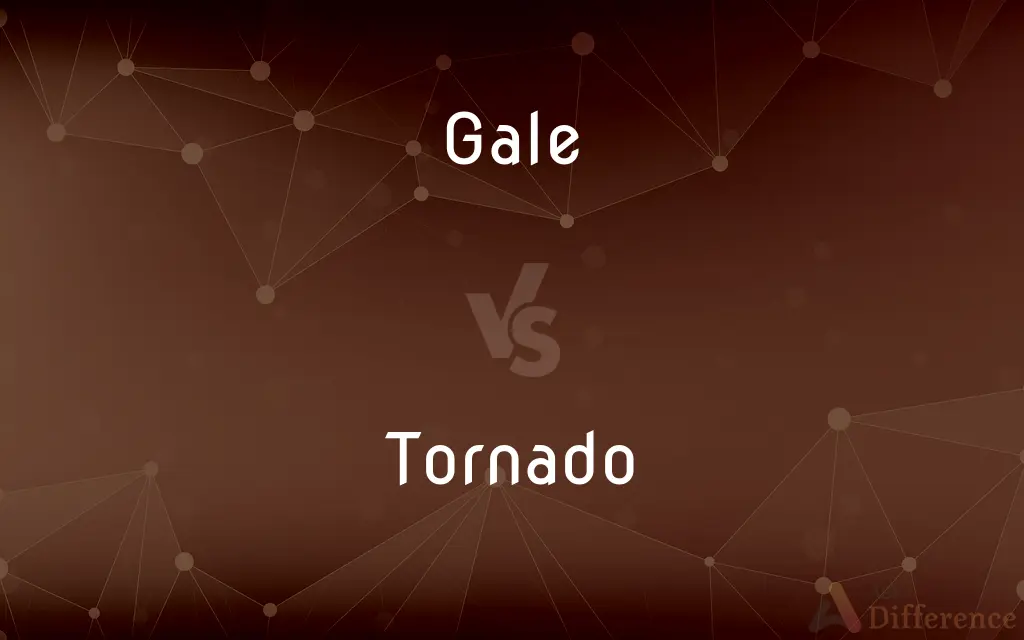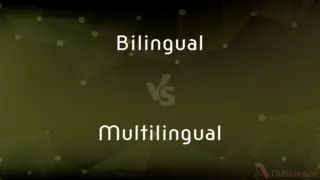Gale vs. Tornado — What's the Difference?
Edited by Tayyaba Rehman — By Maham Liaqat — Updated on April 22, 2024
Gale refers to a very strong wind, typically under 63 miles per hour, while a tornado is a violently rotating column of air extending from a thunderstorm to the ground.

Difference Between Gale and Tornado
Table of Contents
ADVERTISEMENT
Key Differences
A gale is classified meteorologically as a strong wind measuring from 39 to 54 miles per hour on the Beaufort scale, while, on the other hand, a tornado features winds that can exceed 200 miles per hour.
Gales are significant for their horizontal wind movements and can affect large areas, whereas tornadoes are characterized by their localized and vertical wind patterns, causing concentrated damage.
The formation of a gale is typically linked to large differences in atmospheric pressure across a wide area, whereas a tornado forms from severe thunderstorms with a specific type of cloud formation known as a supercell.
Gales can occur both over land and water, impacting shipping and coastal areas significantly, while tornadoes primarily occur over land and are particularly common in Tornado Alley in the USA.
While gales can last for hours or even days as part of larger weather systems, tornadoes are usually brief, lasting from a few seconds to over an hour but are much more destructive per unit area.
ADVERTISEMENT
Comparison Chart
Wind Speed
39-54 mph
Can exceed 200 mph
Duration
Hours to days
Usually a few seconds to an hour
Area of Effect
Large, can be widespread
Localized, narrow path
Primary Formation
Atmospheric pressure changes
Severe thunderstorms (supercells)
Common Locations
Coastal and open areas
Primarily over land, e.g., Tornado Alley
Compare with Definitions
Gale
Often associated with stormy weather.
Gales accompanied the heavy rain last evening.
Tornado
Connected from a thunderstorm to the ground.
The tornado formed rapidly, catching the community off-guard.
Gale
Can cause environmental impact.
The gale caused numerous trees to fall.
Tornado
Studied for prediction and safety.
Tornado researchers are improving early warning systems.
Gale
Used in warnings and alerts.
A gale warning is in effect for all vessels.
Tornado
A violently rotating column of air.
The tornado tore through the town, uprooting everything in its path.
Gale
A meteorological term for wind speed.
The weather forecast warns of a gale developing offshore.
Tornado
Occurs under specific weather conditions.
Tornadoes are more likely to form during severe thunderstorms.
Gale
A strong wind, often at sea.
The ship battled through the night against the fierce gale.
Tornado
Known for extreme destruction.
The tornado left a trail of destruction miles long.
Gale
A gale is a strong wind, typically used as a descriptor in nautical contexts. The U.S. National Weather Service defines a gale as 34–47 knots (63–87 km/h, 17.5–24.2 m/s or 39–54 miles/hour) of sustained surface winds.
Tornado
A tornado is a violently rotating column of air that is in contact with both the surface of the Earth and a cumulonimbus cloud or, in rare cases, the base of a cumulus cloud. The windstorm is often referred to as a twister, whirlwind or cyclone, although the word cyclone is used in meteorology to name a weather system with a low-pressure area in the center around which, from an observer looking down toward the surface of the earth, winds blow counterclockwise in the Northern Hemisphere and clockwise in the Southern.
Gale
A wind with a speed of from 34 to 40 knots (39 to 46 miles per hour; 63 to 74 kilometers per hour), according to the Beaufort scale. Also called fresh gale.
Tornado
A violently rotating column of air extending from a cumulonimbus cloud to the ground, ranging in width from a few meters to more than a kilometer, with destructive winds up to 510 kilometers (316 miles) per hour or higher. Tornadoes are typically associated with a funnel cloud pendant from a storm's wall cloud, often extending to the bottom of the tornado.
Gale
A storm at sea.
Tornado
A violent thunderstorm in western Africa or nearby Atlantic waters.
Gale
Often gales A forceful outburst
Gales of laughter.
Tornado
A whirlwind or hurricane.
Gale
The sweet gale.
Tornado
(meteorology) A violent windstorm characterized by a mobile, twisting, funnel-shaped cloud.
A tornado is a rotating column of air.
Gale
To sing; charm; enchant.
Tornado
A violent whirling wind; specifically (Meteorol.), a tempest distinguished by a rapid whirling and slow progressive motion, usually accompaned with severe thunder, lightning, and torrents of rain, and commonly of short duration and small breadth; a small cyclone.
Gale
To cry; groan; croak.
Tornado
A localized and violently destructive windstorm occurring over land characterized by a funnel-shaped cloud extending toward the ground
Gale
To talk.
Tornado
A purified and potent form of cocaine that is smoked rather than snorted
Gale
To call.
Gale
To sing; utter with musical modulations.
Gale
(nautical) To sail, or sail fast.
Gale
(meteorology) A very strong wind, more than a breeze, less than a storm; number 7 through to 9 winds on the 12-step Beaufort scale.
It's blowing a gale outside.
Many parts of the boat were damaged in the gale.
Gale
An outburst, especially of laughter.
A gale of laughter
Gale
A light breeze.
Gale
A shrub, also called sweet gale or bog myrtle (Myrica gale), that grows on moors and fens.
Gale
(archaic) A periodic payment, such as is made of a rent or annuity.
Gale day - the day on which rent or interest is due.
Gale
A strong current of air; a wind between a stiff breeze and a hurricane. The most violent gales are called tempests.
Gale
A moderate current of air; a breeze.
A little gale will soon disperse that cloud.
And winds of gentlest gale Arabian odors fannedFrom their soft wings.
Gale
A state of excitement, passion, or hilarity.
The ladies, laughing heartily, were fast getting into what, in New England, is sometimes called a gale.
Gale
A song or story.
Gale
A plant of the genus Myrica, growing in wet places, and strongly resembling the bayberry. The sweet gale (Myrica Gale) is found both in Europe and in America.
Gale
The payment of a rent or annuity.
Gale
To sale, or sail fast.
Gale
To sing.
Gale
A strong wind moving 45-90 knots; force 7 to 10 on Beaufort scale
Common Curiosities
How long can a gale last?
Gales can last from several hours to several days, depending on the weather system.
What is the difference in the scale of impact between a gale and a tornado?
Gales affect larger areas more moderately, while tornadoes impact smaller, localized areas but with much more intensity.
How are communities warned about tornadoes?
Communities are warned via emergency alert systems, radios, and television.
What defines a gale in meteorology?
A gale is defined by sustained wind speeds of 39 to 54 miles per hour.
How does a tornado form?
A tornado forms from a severe thunderstorm when warm, moist air meets cold, dry air.
What damage can a tornado cause?
Tornadoes can cause extreme damage, demolishing buildings and uprooting trees.
Can a gale turn into a tornado?
No, gales and tornadoes are distinct meteorological phenomena with different formations.
Are gales dangerous?
Yes, gales can pose significant risks, especially to maritime and coastal activities.
Can tornadoes be predicted?
Tornadoes can sometimes be predicted with modern meteorological technology, providing short-term warnings.
What areas are most affected by gales?
Coastal and open areas are typically most affected by gales.
What safety measures should be taken during a tornado?
Seek shelter in a basement or an interior room away from windows.
What should you do during a gale?
Secure loose objects and stay indoors if possible.
Share Your Discovery

Previous Comparison
Bilingual vs. Multilingual
Next Comparison
Nuke vs. MicrowaveAuthor Spotlight
Written by
Maham LiaqatEdited by
Tayyaba RehmanTayyaba Rehman is a distinguished writer, currently serving as a primary contributor to askdifference.com. As a researcher in semantics and etymology, Tayyaba's passion for the complexity of languages and their distinctions has found a perfect home on the platform. Tayyaba delves into the intricacies of language, distinguishing between commonly confused words and phrases, thereby providing clarity for readers worldwide.
















































